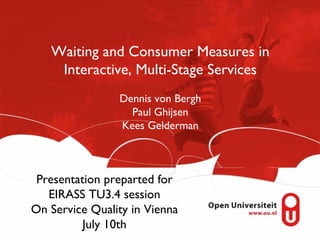
Eirass Presentation July10th Vienna
- 1. Waiting and Consumer Measures in Interactive, Multi-Stage Services Dennis von Bergh Paul Ghijsen Kees Gelderman Presentation preparted for EIRASS TU3.4 session On Service Quality in Vienna July 10th
- 3. Introduction • Increasing importance of services • Increasing value of time for customers (Lovelock and Gummesson, 2004) • Negative influence between waiting time perception and service evaluation • Few studies on waiting in multi-stage services (Hensley & Sulek, 2007) • Pre-process phase with service-entry wait • In-process phase with in-service wait • Post-process phaseLeclerc, 1988) (Dubé-Rioux, Schmitt & with service-exit wait
- 4. Research Objective • Analyse the relative importance of customer perceptions with the waits before, during and following the service delivery in relation to service quality, customer satisfaction and customer loyalty.
- 5. Research Questions • What is effect of wait perception affect consumer measures before, during and following the service? • Which wait perception exerts the largest relative influence? • Does the effect of wait perception on customer metrics differ between service industries? • What is the effect of waiting time satisfaction on waiting time and consumer measures
- 6. Theoretical background 1/3 • Waiting time perception • Service entry wait is predominant: “people want to get started” (Maister, 1985; Davis & Maggard, 1990; Hwang & Lambert, 2005; Hensley & Sulek, 2007) • Objective, subjective, cognitive and affective aspects Demoulin, 2007) (Bielen & • Hierarchical Service Quality Model 2001) (Pollack, 2009; Brady & Cronin, • Service quality, customer satisfaction, customer loyalty (Hayes, 2008; Söderlund, 2006) • Service classification literature • Interaction (Mills & Marguiles, 1980, 1986; O’Farrell & Moffatt, 1991) • Processes (Schmenner, 2004)
- 7. Theoretical Background 2/3 • Service & Marguiles (1980),literatureMoffatt (1991) classification •Mills O’Farrell & • Maintenance interactive services (MIS) • Cosmetic, continuous employee/customer interaction with focus on building trust/confidence to sustain relationship • Restaurants, banks, insurance • Task interactive services (TIS) • Concentrated employee/customer interaction with focus on the task to be performed • Job selection, advertising, engineering • Personal interactive services (PIS) • Focuses on the improvement of the client/customer's direct intrinsic and intimate wellbeing • Dentists, schools, professionals
- 8. Theoretical Background 3/5 • “Revised Service Process Matrix” (Schmenner, 2004)
- 9. Theoretical Background 4/4 • Service evaluation literature: • •consumer measures Pollack (2009), Brady & Cronin (2001) • Service quality • Interaction quality • Physical environment quality • Outcome quality • Hayes (2008), Söderlund (2006) • Customer satisfaction • Transaction perspective • Service perspective • Overall perspective • Customer loyalty • Word-of-mouth • (re)purchase intentions
- 10. Theoretical Background 3/3 • “Hierarchical Service Quality Model” and the Consumer Measures (Pollack, 2009; Brady & Cronin, 2001)
- 11. Adapted Conceptual Model Basic Conceptual Model Waiting time satisfaction Perceived service Service quality entry waiting time Perceived in-service Customer waiting time satisfaction Perceived service Customer exit waiting time loyalty …waiting time satisfaction is a complete mediating variable in the perceived waiting time and service satisfaction link … (Bielen and DeMoulin, 2007)
- 12. Methodology • Selection service venues • Maintentance-interactive services: 4 restaurants • Task-interactive serv.: 1 job selection center 4 processes • Personal-interactive serv.: 1 dental clinic 4 dental proc. • 500 questionnaires per service venue • Simple random sampling (p=.5) Results overview • 1027 respondents included (response rate 68,5%) • 329 Mi (65.8%), 343 Ti (68,6%), 355 Pi (71%) • Age: mean=33, sd=17, min=13, max=87 • 59% Male, 41% female
- 13. Results Basic model Maintenance-interactive Task-interactive Personal interactive restaurants job selection dental * significant p<.05, ** significant p<.01 and *** significant p<.001
- 17. Results Maintenance-interactive Task-interactive Personal interactive • * significant p<.05, ** significant p<.01 and *** significant p<.001
- 18. Conclusions • Findings nuance Maister’s (1985) proposition • “People want to get started” (in Maintenance IS) • “People want to get on with it” (in Personal IS) • “People want to leave asap” (in Task IS) • Two effect-routes of waiting time perception • Central route with high involvement processing and (largest) cognitive formulation of service quality • Peripheral route with low involvement processing and direct effect on customer satisfaction “Elaboration Likelihood Model” (Petty & Cacioppo, 1986)
- 19. Conclusions • Explanation may be suggested from: • “StagesTheory” (Gottschalk & Solli-Saether, 2009) • “Elaboration Likelihood Model” (Petty & Cacioppo, 1986) • Conscious central route • High involvement processing • Cognitive responses • Conscious formulation of service quality • Direct effect of wait satisfaction on service quality • Unconscious peripheral route • Low involvement processing • Customer makes less cognitive effort and • Unconsciously formulation of service quality • Direct effect of wait satisfaction on customer satisfaction
- 20. Limitations, implications and FR • Limitations • Customer demographics • Objective waiting time aspects • Emotional states of consumers (e.g. anxiety) • Consciousness of the wait (awareness) • Theoretical implications • Service settings matter and mediation matters • Managerial implications • Influence relative importance of wait stages (in combination with type of customer interaction) • Further research • Customers’ emotional states (e.g. anxiety) • Customers’ degree of consciousness of a wait situation • Manage expectations via Edutainment or playing games
- 21. Thank you Questions or comments?